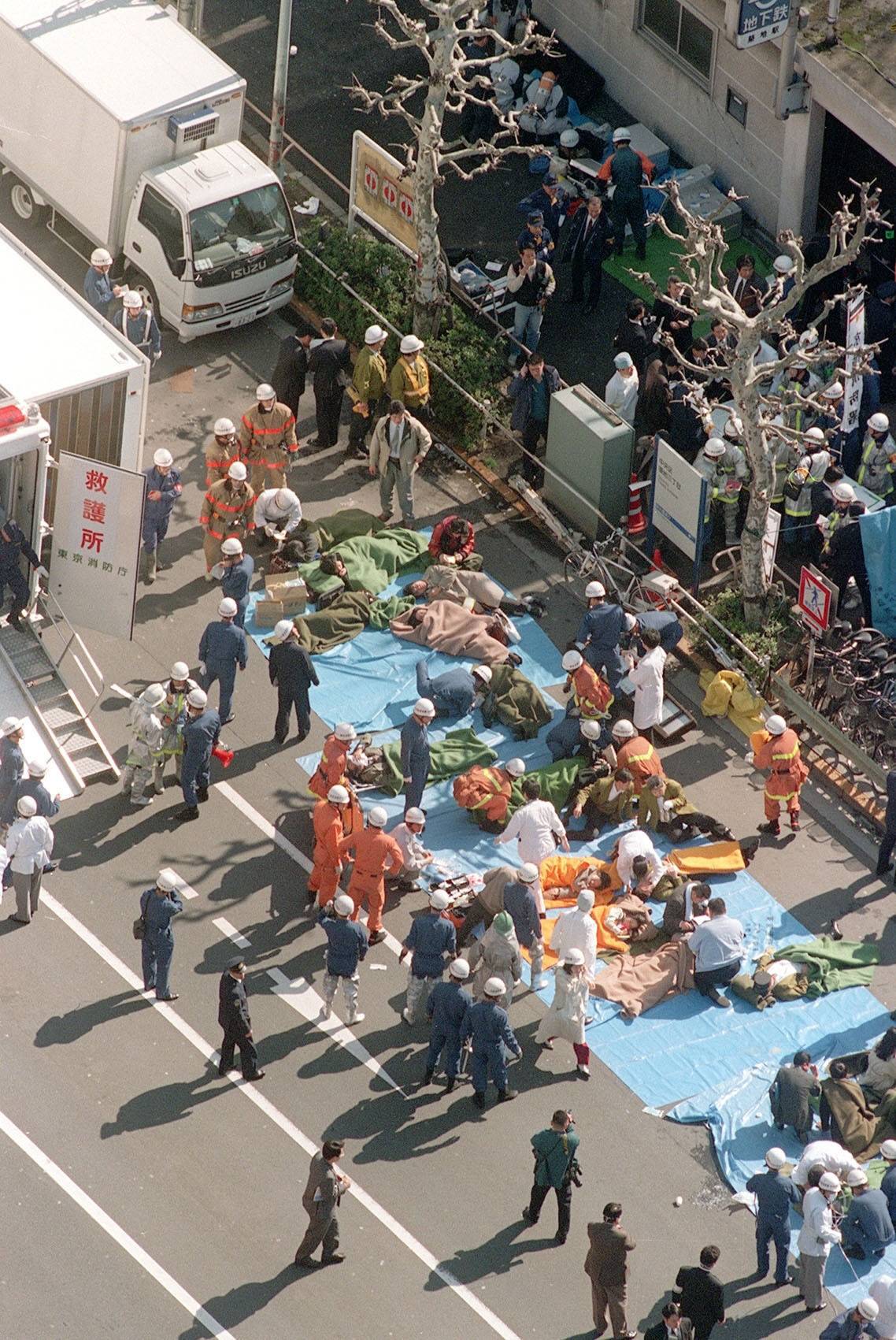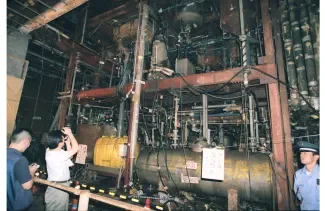The Tokyo SARIN Attack
12 February, 2025
History of SARIN as a chemical weapon
SARIN is an organophosphate acetylcholinesterase (AChE) inhibitor that has a structure similar to the neurotransmitter acetylcholine. SARIN binds to AChE and inactivates it, inhibiting the breakdown of acetylcholine. Acetylcholine activates nerve fibers, causing muscles to contract. If it is not broken down, the muscles don’t relax. SARIN is a lethal gaseous toxin with immediate effects after being absorbed through the respiratory system and the skin. In addition, SARIN that has adhered to clothes or the body may vaporize again and cause secondary damage.
SARIN as a chemical weapon was accidentally discovered in Nazi Germany in 1936 during the synthesis of insecticide. The name “SARIN” was taken from the names of Gerhard Schrader, Otto Ambros, Gerhard Ritter and Hans-Jürgen von der Linde, who were involved in the discovery and development of SARIN. During World War II, SARIN was manufactured but never used in actual combat.
In 1945, following Germany's defeat, the Allied forces obtained detailed information on SARIN from the Nazi scientists. In 1953, the US Army began mass production of SARIN. It was stored in a warehouse at the Rocky Mountain Arsenal and disposed of in the 1970s without being used. In 1988, it is believed that the Iraqi army carried out SARIN attack on the Iranian army and the Kurdish people. In the 1990s, knowledge and technology related to SARIN was lost from history, and in Tokyo, no one, including emergency medical technicians (EMTs), medical staff and police officers, had ever heard of SARIN.
The attack
At the end of the 20th century, Tokyo was known as one of the safest cities in the world, and no one could have imagined that the city would be the target of a mass terrorist attack using chemical weapons. However, in 1993 the religious group Aum Shinrikyo (AUM) secretly began research and development of SARIN and later succeeded in synthesizing it. (Photo on top of the page shows the inside of SARIN synthesis plant constructed by the AUM in a rural region of Japan.)
March 20th, 1995, started out as a normal Monday morning, but the Tokyo SARIN Attack broke out during the morning rush hour. This was because the AUM believed that passenger numbers, including government personnel, peaked at around 8 a.m. The 5 perpetrators, each carrying two 500-600g bags of the SARIN solution, boarded separate trains. While standing near the doors, they used pointed umbrellas to poke the bags several times to diffuse the SARIN. They then disembarked.
Extent of the damage

The total number of symptomatic patients was approximately 5800, and 740 were hospitalized in medical institutions in Tokyo. Of the hospitalized patients, 62.3% were male and 33.2% were female, and the majority were aged between 20 and 40. These figures reflect the gender and age distribution of Tokyo subway passengers at around 8am, who are mainly commuters and students. 89.7% were subway passengers, 5.1% were rescue workers (mostly EMTs), 4.5% were subway staffs and 0.3% were police officers. 43.4% of patients were taken to the hospital by ambulance, 36.1% came on foot, and 12.2% came by taxi [1]. Eventually, 13 people died, and many patients had severe neurological injuries or sequelae. It should be noted that around 10% were considered to be secondary casualties. 135 EMTs were reported to manifest symptoms related to the secondary exposure to SARIN.
The Tokyo Metropolitan Bokuto Hospital (TMBH) and St. Lukes International Hospital were the two large-scale medical institution closest to the incident sites and received many patients. On the day, TMBH received and treated approximately 100 patients with respiratory and neurological symptoms, including 4 severely affected patients transferred by ambulance, and 1 severest patient requiring immediate resuscitation and intensive care.
Diagnosis and treatment of the patients
On arrival, most of the patients (>90%) complained of a sense of darkness and manifested miosis (contraction of pupils). Many (30%~50%) complained of headache, nausea and shortness of breath. Some (<30%) manifested arrythmia (bradycardia, Vf), drooling (increased secretion) and consciousness disturbance.
These symptoms (miosis, bradycardia, increased secretion) were similar to those of organophosphate AChE pesticide poisoning, but the medical staff involved in the first response, including myself, were not even aware of the existence of organophosphate AChE inhibitors, which being gaseous, cause damage through inhalation or skin exposure. In addition, it took 24 hours to obtain the results of the measurement of serum cholinesterase (ChE) level, which is a diagnostic biomarker for organophosphorus AChE inhibitor poisoning.
Therefore, we decided to start administering atropine sulfate as a symptomatic and diagnostic treatment based on experience from organophosphate AChE inhibitor insecticide intoxication. The treatment showed immediate effect in terms of reliving miosis, bradycardia and drooling, and we were able to believe to some extent that the patients were suffering from poisoning by an unknown organophosphate AChE inhibitor. However, the effect only lasted for a relatively short period of time, and repeated administration of atropine sulfate resulted in an overdose, causing side effects (such as fever, blinding brightness, and constipation) in quite a number the patients.
Around this time, the Scientific Police Research Institute (SPRI), who were analyzing the remnants in the bags poked by the perpetrators, announced that they had detected and identified acetonitrile (methyl cyanide). Although the toxicity of acetonitrile is significantly lower than that of inorganic cyanide compounds, it is rapidly absorbed through inhalation or the skin and metabolised by cytochrome P450 to produce inorganic cyanide. Acetonitrile is an organic solvent, and it was later revealed that the AUM used acetonitrile as a solvent for SARIN to make it easier to handle when spraying. At that time, SPRI was under extreme pressure to identify the causative agent as quickly as possible, so we can't blame them for this somewhat premature announcement, but in the event this announcement caused confusion among the medical staff treating the patients. The problem was that the treatment for inorganic cyanide poisoning is completely different from that for organophosphate AChE inhibitor poisoning.
Then, we received informationby telephone call and fax from Shinshu University School of Medicine, which clearly identified the incidence as a mass intoxication of SARIN, based on experience of a similar but far smaller scale incident of SARIN intoxication, caused by the AUM several months before. The information also revealed the nature of SARIN as a gaseous organophosphate AChE inhibitor and recommended administration of pralidoxime methiodide (PAM). This information provided us with a solution to our doubts and confusion, and we began administering PAM to the critically ill patients. Consequently, we saw a marked improvement in the patients’ general condition.
However, at the time, no one at TMBH imagined or expected that mass organophosphate AChE inhibitor poisoning would occur, and the hospital had only a few vials of PAM in stock. In this emergency situation, thanks to the hard work of several pharmaceutical distributors, the hospital was able to secure several dozen vials of PAM within a few hours. Among the 740 hospitalized patients, only 253 (36.5%) received PAM. Therelative recovery rate of patients who received serum ChE + PAM was significantly higher than those who only received single agent treatment, and those who received nether drug.
Lessons learnt from the response to the Tokyo SARIN attack
It is not possible nor pragmatic to expect staff working on the front line of medical care to have the knowledge and diagnostic and therapeutic capabilities regarding rare toxins (including biotoxins). For this reason, it is necessary to establish a centralised network for collecting information and samples, detecting and identifying toxic substances, and providing appropriate recommendations regarding diagnosis and treatment, and to secure the availability of the necessary resources.
Of course, Sarin is not a biological toxin. However, I have posted this article to share the lessons learned from responding to a large-scale chemical terrorist attack using an unknown toxin 30 years ago with the EMBRACE partners and the many people who visit the website. I sincerely hope this article will help readers to make sense of the motivations for, and importance of, the project.
Header Image: IMAGO / Kyodo News © AUM Shinrikyo cult File photo taken in September 1998 shows the Satyam 7 facility at the AUM Shinrikyo cult s complex in Kamikuishiki, west of Tokyo. The cult mass produced sarin nerve gas at the facility.
[1] Maekawa K. Tokyo Metro ‘SARIN Gas Attack’ Acute Poisoning Information. The Japanese Journal of Clinical Toxicology 10: 38-41, 1997. (Japanese)
